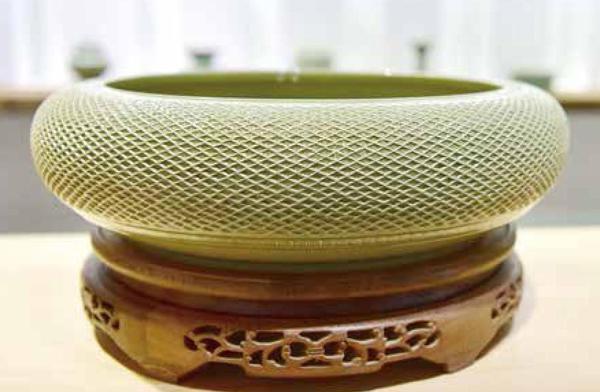越窑青瓷有传人
2018-10-11赵畅
赵畅
对绍兴市上虞区的“顾氏越窑”窑主、青年陶艺家顾少波,我是未见其人而先闻其名。他是G20杭州峰会青瓷礼物一套4件“和”字盘(寓意“世界和平”,书法“和”由著名残疾人书法家陈伟强书写)的承制者,其创作的青瓷作品先后获得全国26个金奖,其中由中国轻工业联合会颁发的就有6个。
我怎么也没想到,顾少波在从事青瓷研究之前是一名厨师,曾在五星级的宁波开元名都大酒店的厨房里从事雕刻工作。因是宁波技校烹饪专业的毕业生,属科班出身,他的果蔬雕刻技艺自是了得,先后获过不少的奖项。
时间到了2010年8月,这一天无疑是改变他人生命运的时刻。被先前在上虞陶瓷厂工作、而今已是浙江省工艺美术大师的舅舅董文海所感染,顾少波毅然辞职,回到家乡跟随舅舅学习青瓷制作。
顾少波虽是初次接触青瓷工艺,但不知为何,他一触碰瓷土,一练一捣间,便情难自已、爱不释手,并暗暗下了决心:“自己的这一生,从此就将交给青瓷。”四年间,从做拉坯、雕花学徒到个人成立“顾氏越窑”研究所,他把全部的精力和财力都投入到了青瓷研究制作之中。
创业路途上的艰辛可想而知。然而,在他看来,最为重要的还是对传统越窑瓷器的参悟和还原。不熟知、不搞懂老祖宗的东西,不知道来路,又怎么叫青瓷研究呢?为此在一段时间内,顾少波将自己的精力更多地放在了对家乡青瓷古窑址的探访,对碎瓷片的收集整理、研究上。家乡说得上名的古窑址和散落荒野不为常人所知的一些古窑址,都留下了他的串串脚印。自然,这些古窑址和碎瓷片属于哪个朝代甚至大概属于哪些年份,他可以一一道来且少有差池。顾少波抓住了这些古窑址的特性,并且透过碎瓷片,对各个朝代和阶段的青瓷是如何从练泥、拉坯到上釉、烧制的工艺,有了清晰和透彻的了解。
知其然且知其所以然,不免让顾少波信心满满。然而制瓷之路并非坦途。让顾少波记忆犹新的是,那次他将大量精美的半成品小心翼翼地放进窑里,就等着“九秋风露越窑开,夺得千峰翠色来”那美妙的一刻。可因为自己的一时粗心,没有打开窑炉的烟道,致使窑内温度骤然下降,里面浓烟滚滚,所有的半成品毁于一旦。“吃一堑,长一智”,这次失败让他真正懂得注重细节的重要,并开始养成事必躬亲的良好习惯。不久,当他成功烧制出第一窑作品的时候,他雀跃,他陶醉。或许,与他现在的作品比,那些东西尚显稚嫩、粗粝,釉面不匀,缺乏莹润感,但这毕竟是自己的第一个“孩子”。在他的样品陈列室,至今还保留着其中的几件作品,不为别的,只是为了回望历程、回味甘苦、回归初心。
顾少波对于青瓷研究的痴心确实让人钦佩。早先几年,他几乎没有整块的休息时间,整日整夜地沉浸在青瓷的世界里,一步一个脚印地学习着各个朝代、不同时期的传统制瓷工艺。他曾靠着一块不到5平方厘米的碎瓷片,生生还原制作了一件仿唐代青瓷器。
2013年10月,顾少波第一次参加全国比赛,他的作品《莲之昭昭》和《月夕花朝》在中国工艺精品博览会上获全国银奖、铜奖,他也同时成为全国最年轻的获奖者。“只要你真诚地投入、真心地喜欢、真正地快乐,你就能成功。”这是他获奖后对采访他的记者们说的。
自此以后,他似乎成了获奖“专业户”。
近年来,顾少波又将目标定在了恢复秘色瓷上。越窑秘色瓷,又称秘瓷、秘色越器。“秘色瓷”就是用保密的釉料配方涂抹器物表面而烧成的瓷器。秘色瓷特殊的釉料配方,能产生瓷器外表如冰似玉的美学效果,釉层特别薄,釉层与胎体结合特别牢固。每次见到图册中的秘色瓷,顾少波总是将信将疑,直到有一天,在家鄉古代官窑遗址上拾得一爿珍稀的秘色碎瓷片时,方知用“千峰翠色”描述是多么的传神和逼真,“雨过天青色,不可道啊!”
然而,秘色瓷越是神秘,顾少波越是想要破解。功夫不负有心人,一年多的研究攻关,他初获成功。在今年以仿法门寺出土的秘色瓷釉色和上虞傅家岭官窑出土的秘色瓷标本为标准的“第二届上虞区秘色瓷作品评选”中,他脱颖而出,其参评的作品一举夺得一等奖。
顾少波做学徒的时候,只负责拉坯和雕花,几乎不接触调釉和烧制。但调釉和烧制是还原古青瓷器的核心。成立研究所后,顾少波就将研究的重点放到了调釉和还原烧制技艺上。为此,他一方面勤奋读书,独立钻研;一方面则拜师求教,以避免走弯路。在短短的几年里,他得到了多位大师的指导、勉励,让这个初出茅庐的小伙子受宠若惊;而每一次的失败或成功,都让他感到青瓷学问的博大精深,感叹家乡老祖宗的聪明才智。
在传承越窑青瓷传统工艺的同时,有一个问题一直横亘在顾少波心里而挥之不去:恢复青瓷工艺已经迈出了一大步,下一步该如何走?毕竟,恢复越窑青瓷传统工艺只是手段,我们的目的是要实现青瓷的创新,实现青瓷与人们生活的对接。
是的,传统的越窑青瓷历来以瓷质细腻、线条明快流畅、造型端庄浑朴、色泽青翠晶莹等特点著称,而随着经济社会的发展和人们生活观念的转变,青瓷制品也正被时代赋予新的使命,开始融入人们的日常生活。
“把古老的越窑青瓷与现代人的审美观相结合,让日用陶瓷艺术化,艺术陶瓷日用化,就是我的努力方向。”将青瓷的创作拉回到生活的原点,让现代陶艺与现代人的生活发生关系,这既是尊重物质创造的表现,也是尊重生命的体现。而将青瓷文化与茶道、花道结合,成了他的突破口。
说到将青瓷制品与花艺、茶道结合,这份灵感源于他与朋友的一次聚会。那次喝茶时,他被茶具、花器所吸引,并有幸结识了几位来自中国台湾的茶道老师和来自日本的花艺大师。在与他们的交谈中,顾少波突发奇想:自己若能将花艺与茶道融入青瓷作品中,视顾客的需求打造不同的青瓷器型,这样的青瓷产品不就更具实用性了吗?回来后,他参考了网上的一些茶盏和花器的照片,又自己动手设计,并将样品照片发送给相遇的几位大师,请他们提出修改意见。当第一批茶盏和花器发往日本等地后,竟获得好评。自此以后,订单络绎不绝。
順乎文创产业的快速发展,前不久,顾少波还为绍兴兰亭开发了一款文创产品。这是一套以一对男女使用的茶具为组合的“忆兰亭”快客杯。定睛细看,其创意满满:茶杯中间两边的手把纽平面上刻有王羲之的“之”字,杯盖的盖纽是用“鹅”形制作的,杯子底部中间则刻有“永和”字样——既是对“永和九年”的纪念,也蕴含着“永远和和美美”的意思。其中男士使用的杯子选用了魏晋时期越窑青瓷的釉色,显得古朴、稳重;而女士使用的杯子则选用唐五代的秘色釉,给人以温润、细腻的感觉。
At 30 in 2018, Gu Shaobo, a celadon master based in Shangyu, a district of Shaoxing City in eastern Zhejiang, has long since established himself as a brilliant genius of celadon designing and making. For his celadon creations, he has won 26 gold prizes at the national level, including six issued by China Light Industry Association. Some of his masterpieces are in private and institutional collections.
Few would know that Gu Shaobo worked as a chef before he turned to celadon making. A graduate from a culinary school, he worked at a restaurant of a five-star hotel in Ningbo. His vegetable and fruit sculptures won him many professional glories.
In August 2010, the 22-year-old chef resigned from his job and went home to study celadon making under the guidance of his maternal uncle Dong Wenhai, a provincial master of arts and crafts who used to work at Shangyu Porcelain Factory. This career change has brought fundamental changes in the young man. Though he had never put his hands on celadon making before, he soon fell in love with the wonderful art. He determined to dedicate his life to celadon making. Over the following four years, he studied and mastered the essentials and eventually set up his own research institute.
The first important step he took in mastering the ancient art was to go back to the past. He visited the sites of ancient kilns around Shangyu. He collected the porcelain shards and studied them piece by piece. He soon acquired a thorough knowledge of renowned kiln sites and little-known kiln sites in the region. A thorough study of the shards opened his eyes to the secrets of production procedures at different kilns of different dynasties.
He thought he was ready to make his own celadon pieces. But the first batch was a total failure, for he made a mistake in opening the chimney when the firing was done. The costly failure was a precious lesson. He learned to pay attention to all the details. In the first few years, he spent nearly all the time studying the details of celadon making. With a shard which was smaller than 5 square centimeters as a prototype, he miraculously reproduced a celadon piece in the style of the Tang dynasty.
Gu rose to national fame in October 2013 when he first took his celadon artworks to a national competition. Two of his celadon pieces won respectively a gold medal and a bronze medal. At 25, he was the youngest winner. After the debut in 2013, he became a constant winner of gold medals.
When in his apprentice years, Gu focused on making the body and carving patterns on the body. He seldom put his hands on glazing and firing, the two key steps in celadon making. After he set up his own research institute, he shifted his focus onto the key steps. He read books and consulted masters so as to avoid making mistakes. He studied under many masters. Their generous tips and teachings benefited him a great deal.
While learning about the ancient techniques in celadon making, he pondered the next step he was going to take, with the major techniques successfully restored and mastered. His answer was to bring innovation into celadon and bring celadon into everyday life. His aim was to make household celadon pieces so as to make celadon a part of life.
His first inspiration came when he met with some tea masters from Taiwan and florist masters from Japan. When the conversation turned to utensils used in the tea ceremony and the flower ceremony, he thought he could make better celadon pieces for these ceremonies. Back home, he searched online and designed some pieces. He sent the photos of his prototypes to the masters he had met before and asked them for comments and advice. The first batch of tea sets and flower utensils he sent to Japan was well received. Orders came in.
As Zhejiang is promoting the protection and utilization of the Yue Kiln and celadon making, his business is going to tap into the opportunities opened up in the fields of culture, tourism, leisure events, souvenirs, communication. He is going to position his business and contribute his bit to the development of the provinces celadon industry.
